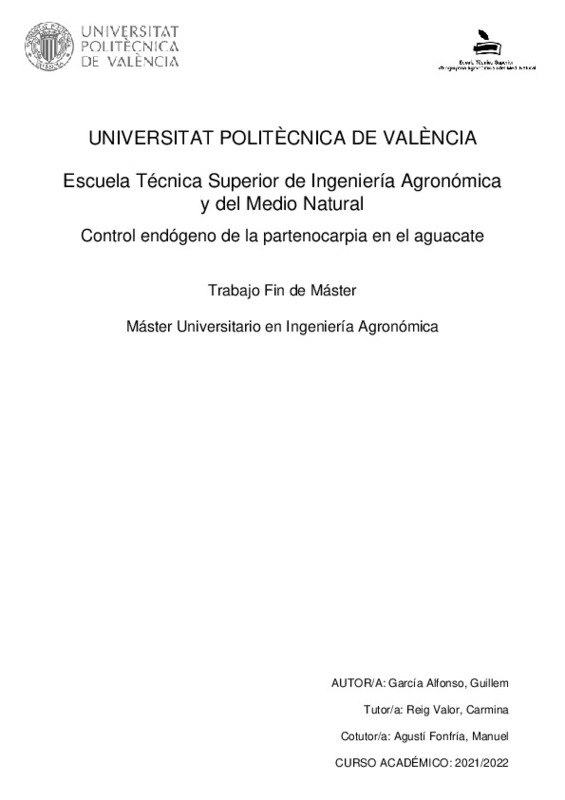JavaScript is disabled for your browser. Some features of this site may not work without it.
Buscar en RiuNet
Listar
Mi cuenta
Estadísticas
Ayuda RiuNet
Admin. UPV
Control endógeno de la partenocarpia en el aguacate
Mostrar el registro sencillo del ítem
Ficheros en el ítem
| dc.contributor.advisor | Reig Valor, Carmina
|
es_ES |
| dc.contributor.advisor | Agustí Fonfría, Manuel
|
es_ES |
| dc.contributor.author | García Alfonso, Guillem
|
es_ES |
| dc.date.accessioned | 2022-10-17T09:29:43Z | |
| dc.date.available | 2022-10-17T09:29:43Z | |
| dc.date.created | 2022-09-26 | |
| dc.date.issued | 2022-10-17 | es_ES |
| dc.identifier.uri | http://hdl.handle.net/10251/187945 | |
| dc.description.abstract | [ES] La aplicación repetida de ácido giberélico (GA3) a una concentración de 50 mg l-1 durante el periodo de floración, desde la flor en preantesis hasta su antesis, provoca la partenocarpia en el aguacate, tal como ocurre en otros frutales de cuajado sexual. Mediante esta técnica se consiguen obtener frutos sin semillas, conocidos como paltines, que, de acuerdo con las exigencias del mercado, resultan de especial interés para el sector productor. Pero el tamaño alcanzado por éstos es insuficiente y no alcanza el calibre comercial exigido. Es por ello, que en este trabajo se plantea mejorar el tamaño de los paltines mediante la aplicación de 2 auxinas de síntesis después de la primera caída fisiológica del fruto. Por una parte, se aplicará 2,4-DP a una concentración de 25 mg l-1 y, por otra, 3,5,6-TPA a 15 mg l-1 . En ambos casos se consiguió mejorar significativamente el diámetro ecuatorial y longitudinal respecto del control en un 10% y 4%, respectivamente para el 2,4-DP y en un 13% y 12% para el 3,5,6-TPA. En consecuencia, el peso del fruto aumentó en un 24% y 47%, respectivamente, respecto del control. Con el fin de estudiar si la ausencia de semilla influye en el contenido de materia grasa, se determinará el % de materia seca de los frutos. Adicionalmente, se estudiará si el mecanismo de acción de las giberelinas en la obtención de frutos partenocárpicos de aguacate es a través de desacoplar el periodo de polinización efectiva (PPE), como ocurre en otras especies frutales. Para ello, se estudiará el contenido hormonal y nutricional de los frutos a lo largo del cuajado y desarrollo del mismo, así como se determinará, mediante microscopía de fluorescencia, la presencia de calosa en los óvulos de los frutos tratados que indica la degeneración de los mismos y, en consecuencia, el desacople del PPE. | es_ES |
| dc.description.abstract | [EN] The repeated application of gibberellic acid (GA3) at a concentration of 50 mg l-1 during the flowering period, from the flower in pre-anthesis to its anthesis, causes parthenocarpy in avocado, as it occurs in other fruit set. sexual. Through this technique, it is possible to obtain seedless fruits, known as paltines, which, in accordance with market demands, are of special interest to the producing sector. However, the size reached by these is insufficient and does not reach the required commercial caliber. Therefore, in this work, it is proposed to improve the size of the pallets by applying 2 synthetic auxins after the first physiological fall of the fruit. On one hand, 2,4-DP will be applied at a concentration of 25 mg l-1 and, on the other hand, 3,5,6-TPA at 15 mg l-1. In both cases, it was possible to significantly improve the equatorial and longitudinal diameter with respect to the control by 10% and 4%, respectively for 2,4-DP and by 13% and 12% for 3,5,6-TPA. Consequently, fruit weight increased by 24% and 47%, respectively, compared to the control. In order to study if the absence of seed influences the fat content, the % dry matter of the fruits will be determined. Additionally, it will be studied if the mechanism of action of gibberellins in obtaining parthenocarpic avocado fruits is through uncoupling the effective pollination period (EPP), as occurs in other fruit species. For this, the hormonal and nutritional content of the fruits will be studied throughout the fruit set and its development, as well as the presence of callose in the ovules of the treated fruits, which indicates the degeneration of the ovules, will be determined by fluorescence microscopy. themselves and, consequently, the decoupling of the EPP. | es_ES |
| dc.format.extent | 37 | es_ES |
| dc.language | Español | es_ES |
| dc.publisher | Universitat Politècnica de València | es_ES |
| dc.rights | Reserva de todos los derechos | es_ES |
| dc.subject | Parthenocarpy | es_ES |
| dc.subject | Pollination | es_ES |
| dc.subject | Partenocarpia | es_ES |
| dc.subject | Auxines | es_ES |
| dc.subject | Calosa | es_ES |
| dc.subject | Polinización | es_ES |
| dc.subject.classification | PRODUCCION VEGETAL | es_ES |
| dc.subject.other | Máster Universitario en Ingeniería Agronómica-Master Universitari en Enginyeria Agronòmica | es_ES |
| dc.title | Control endógeno de la partenocarpia en el aguacate | es_ES |
| dc.title.alternative | Endogenous control of parthenocarpy in avocado. | es_ES |
| dc.title.alternative | Control endogen de la partenocàrpia en l'alvocat | es_ES |
| dc.type | Tesis de máster | es_ES |
| dc.rights.accessRights | Abierto | es_ES |
| dc.contributor.affiliation | Universitat Politècnica de València. Departamento de Producción Vegetal - Departament de Producció Vegetal | es_ES |
| dc.contributor.affiliation | Universitat Politècnica de València. Escuela Técnica Superior de Ingeniería Agronómica y del Medio Natural - Escola Tècnica Superior d'Enginyeria Agronòmica i del Medi Natural | es_ES |
| dc.description.bibliographicCitation | García Alfonso, G. (2022). Control endógeno de la partenocarpia en el aguacate. Universitat Politècnica de València. http://hdl.handle.net/10251/187945 | es_ES |
| dc.description.accrualMethod | TFGM | es_ES |
| dc.relation.pasarela | TFGM\150715 | es_ES |
Este ítem aparece en la(s) siguiente(s) colección(ones)
-
ETSIAMN - Trabajos académicos [3541]
Escuela Técnica Superior de Ingeniería Agronómica y del Medio Natural






